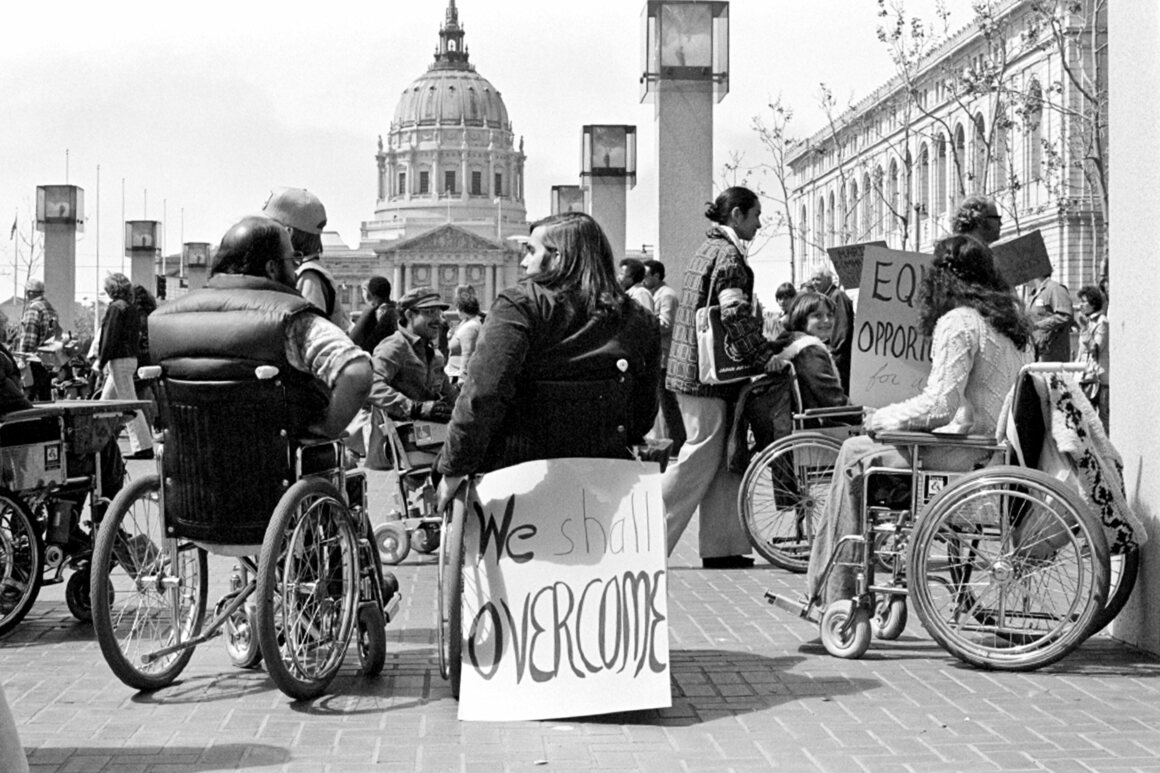Last week many of us participated in Global Accessibility Awareness Day (GAAD). On that day, I had the privilege to listen to a keynote address by Judy Heumann during Knowbility’s virtual AccessU. Some may know Ms. Heumann from leadership positions in the U.S. Dept of Education, the World Bank, or the U.S. State Department. Others would know her as a lifelong civil rights activist in the disability movement, or as an internationally-awarded and Oscar nominated contributor to the Netflix documentary Crip Camp (this is a must see IMHO).
I’m both energized and haunted by her keynote. She recounted lessons from the disability movement of the past and efforts to secure a more accessible present and future. While the entirety of her speech was amazing, there is one concept I can’t seem to get out of my head. Ms. Heumann reminded us all that if we want to change the status quo we must “show up to disrupt”.
She shared this phrase in the context of her lifelong civil rights activism. Ms. Heumann recounted a tremendous disappointment when, after years of disability activists working within the system to bring about policy changes, the Nixon Administration and Congress rejected the proposal to define disability as a protected class under federal law. This giant blow caused a powerful response. It resulted in civil disobedience actions that subsequently framed the disability movement and civil rights legislation for those with disabilities in the U.S.

Some of you will recall the mid 70’s and 80’s where individuals in wheelchairs chained themselves to, or surrounded, busses to protest inaccessible transportation. Law enforcement may have been familiar with clearing away protestors, but moving people in chairs was difficult. Moreover, paddy wagons and jails were not accessible either, so there were few places to move them to. Before buildings were required to be accessible, individuals disrupted the status quo by crawling up steps and staircases to state and federal buildings to speak with legislators and participate in our democracy. Then there was the longest non-violent occupation of a federal building in the history of the U.S. The 504 Sit-In helped change the status, in law, of those with disabilities. Of course, the rest is history. The passage of Section 504 in the Rehabilitation Act became the first federal nondiscrimination provision for persons with disabilities. 13 years later, the Americans with Disabilities Act was signed into law.
Nobody can know the direct effect that these acts of civil disobedience had on the passage of nondiscrimination laws, but in my opinion, the disability community would remain unprotected were it not for these bold actions by bold people to “show up to disrupt” the status quo.
Let’s now take that lesson and focus on digital spaces. Like the 70’s and 80’s push to make the built environment accessible as key to inclusion, we have had decades of work on digital accessibility. So how are our outcomes? Certainly, there are some improvements. Certainly, technology has made a difference. Certainly, more people are aware, more have received training than ever before, and more developers and designers apply accessibility in what they do. Certainly, more and more entities make commitments for accessibility. Certainly, court decisions have shaped our work. Yet as the web grows logarithmically and our society increasingly relies on digital goods and services, are we keeping up? The results of the WebAIM Million attest to the snail’s pace of progress broadly. When the Department of Justice halted efforts under the Trump Administration to create a federal definition of digital accessibility, many of us felt disappointment and even anger. Now we have the controversial Winn-Dixie ruling. While the case may be heard again, the initial judgement took a collective breath away from many of us who had been used to seeing the courts identify the need for digital access as a vital aspect of nondiscrimination and basic inclusion in today’s society.
Some may feel we are on the right path, the right trajectory. I do not. Like Ms. Heumann, I am getting tired of the status quo. We seem to address accessibility one — entity — at — a – time. So then, I want to ask how can I, how can WebAIM, how can the accessibility community, show up to disrupt? Prior disruptions were led by those with disabilities (with allies at their side), happened publicly, were covered by the media, and made a lasting difference. Can we do something similar to promote digital inclusion?
I invite you to share your thoughts on what it means right now for the disability and accessibility community to show up to disrupt. As I have had this conversation with my colleagues at WebAIM, the conversations steered toward how our research and the media attention it receives could be disruptive. For example, WebAIM documented the accessibility of COVID sites. This was covered broadly. It did make a difference as the accessibility of some websites was improved in the face of what we presented. Yet was it disruptive? That statement feels a half-a-bubble off somehow. The newly announced GAAD Foundation has promised to be disruptive in industry. They will work initially to secure pledges so that open source efforts are accessible (they had a positive impact on improving the React framework last year). But in all of these things, I hear our work happening as it would have. Not happening as a way to disrupt.
If we embrace the thinking that history instructs us, we should want to heed Ms. Heumann’s advice to “Show up to disrupt”. While I am not sure I know what that means for those of us who battle digital discrimination, I do know I would welcome a steady stream of disruptive tactics. So, what will that be for you? How can you engage in civil disobedience on this issue. More importantly, will you?

Yes! Thank you for writing this. Representation is crucial. Have a nice day.